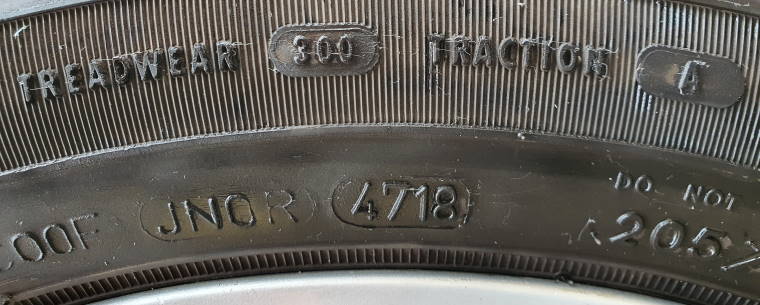Tyre Age - How Old Are My Tyres?
To help identify the age of your tyres, each one is imprinted with a coded date which tells you when that tyre was manufactured.
The four-digit tyre age code is usually located in a window on the tyre sidewall. The first two digits of the code represent the week of production during the year (from 1 to 52) while the second two digits represent the year of manufacture.

In this example, the manufacture date code is 4718 - where 47 denotes the week of manufacture and 18 represents the year, meaning the tyre manufacture date was the 47th week of 2018.
If your tyres are printed with only a 3-digit number, it means your tyres were manufactured before 2000 and should be replaced asap. There is no definitive tyre age limit as to when you should replace your tyres but once your tyres reach 7-10 years old, you should keep a close eye on their condition and consider replacing them.
Tyre ageing is commonly identified by small cracks, known as crazing, which appear in the tyre sidewall. This is brought about when UV light oxidises the rubber, causing it to dry out.
While tyres contain anti-oxidising chemicals which significantly slow down the rate of ageing, this wax-like substance is only released when the tyre is in motion. Therefore, if the tyre is not used frequently or is stored away ineffectively, they will age more quickly – rendering them unroadworthy when returned to use. Low mileage, older cars tend to be most at risk from premature ageing – as drivers assume the tyres are still in good condition if they have plenty of tread.
Premature tyre ageing can affect safety and increase the risk of tyre failure. For this reason, Kwik Fit recommends drivers with tyres that are six years old or more to have them checked professionally in order to ensure they are still safe for use. Remember to check additional tyres such as spare wheels or those fitted to caravans and trailers as these tyres typically see less use and will be more susceptible to tyre ageing.
Tyre Age when buying new tyres
Tyres are considered to be ‘new’ and are suitable for retail sale for, up to 5 years from the original date of production with recommended storage guidance from tyre manufacturers.
The industry standard for tyres, based on the German BRV recommendation, is the ‘5 year rule’ for new tyres.
When buying a new tyre, make sure you know what size you need. Don't know how? Learn how to find your tyre size here.






